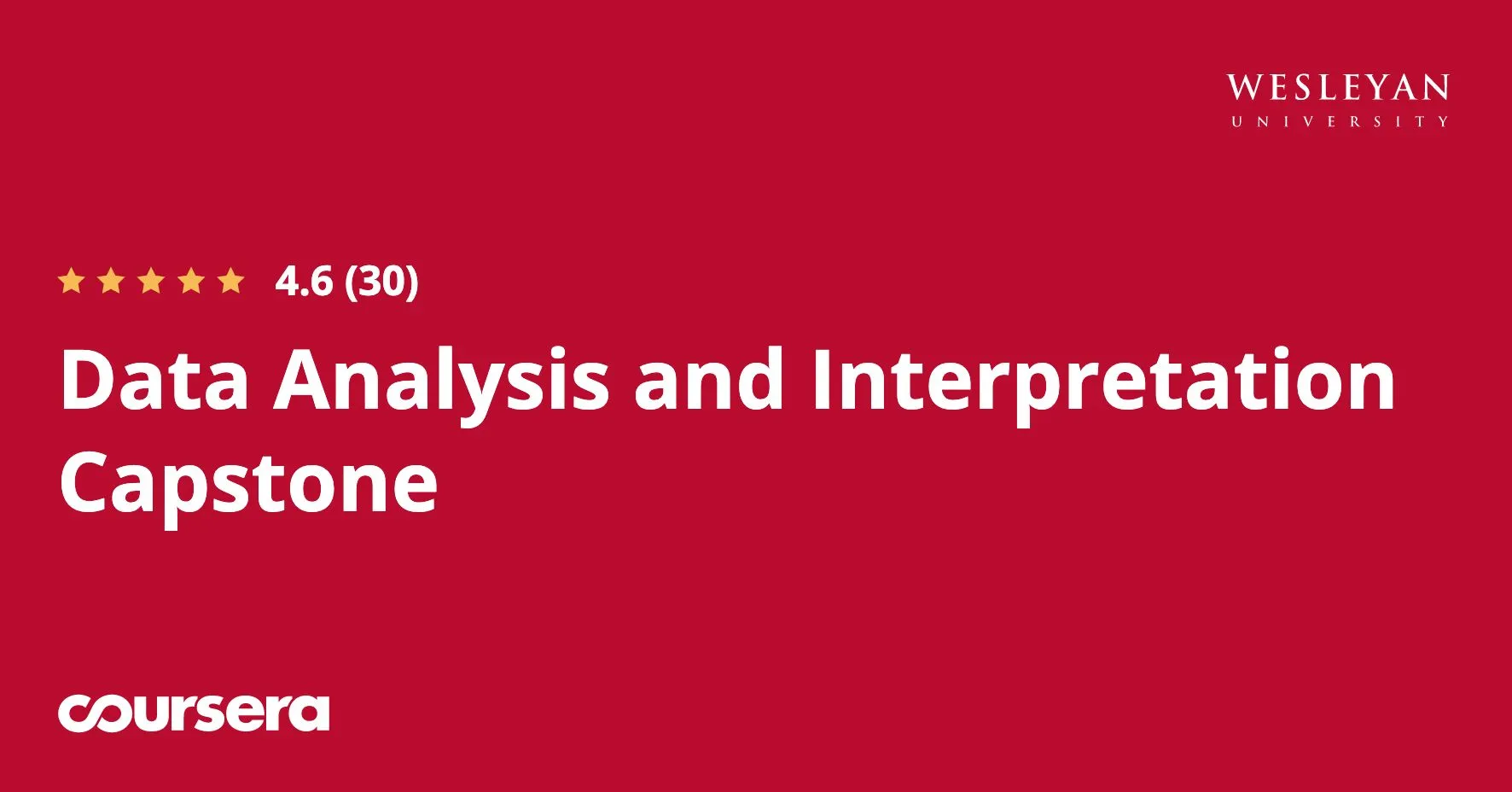
Data Analysis and Interpretation Capstone 
The Capstone project will allow you to continue to apply and refine the data analytic techniques learned from the previous courses in the Specialization to address an important issue in society. You will use real world data to complete a project with our industry and academic partners. ▼
ADVERTISEMENT
Course Feature
![]() Cost:
Cost:
Free
![]() Provider:
Provider:
Coursera
![]() Certificate:
Certificate:
No Information
![]() Language:
Language:
English
![]() Start Date:
Start Date:
Self Paced
Course Overview
❗The content presented here is sourced directly from Coursera platform. For comprehensive course details, including enrollment information, simply click on the 'Go to class' link on our website.
Updated in [March 06th, 2023]
This Data Analysis and Interpretation Capstone course provides students with the opportunity to apply the data analytic techniques they have learned throughout the Specialization to a real-world problem. Students will work with industry and academic partners to analyze and interpret data to address an important issue in society. Through this project, students will gain experience in data collection, cleaning, analysis, and interpretation. Upon completion of the course, students will have a comprehensive understanding of the data analysis process and be able to apply their skills to a variety of data-driven problems.
[Applications]
The Data Analysis and Interpretation Capstone provides students with the opportunity to apply the data analytic techniques they have learned in the Specialization to a real-world problem. Students will use real-world data to complete a project with industry and academic partners. After completing the course, students will have the skills to analyze data, interpret results, and communicate their findings to stakeholders. They will also be able to apply these skills to their own data analysis projects.
[Career Paths]
1. Data Scientist: Data Scientists are responsible for analyzing large amounts of data to uncover trends and insights. They use a variety of techniques, such as machine learning, statistical analysis, and data mining, to uncover patterns and develop predictive models. Data Scientists are in high demand, and the demand is expected to continue to grow as more organizations rely on data-driven decision making.
2. Business Intelligence Analyst: Business Intelligence Analysts are responsible for collecting, analyzing, and interpreting data to help organizations make better decisions. They use a variety of tools and techniques to uncover trends and insights, and then present their findings to stakeholders. The demand for Business Intelligence Analysts is expected to grow as organizations continue to rely on data-driven decision making.
3. Data Engineer: Data Engineers are responsible for designing, building, and maintaining data systems. They use a variety of technologies, such as databases, data warehouses, and big data platforms, to store and process data. Data Engineers are in high demand, and the demand is expected to continue to grow as organizations rely more and more on data-driven decision making.
4. Data Visualization Specialist: Data Visualization Specialists are responsible for creating visual representations of data to help organizations better understand their data. They use a variety of tools and techniques to create interactive visualizations that can be used to explore and analyze data. The demand for Data Visualization Specialists is expected to grow as organizations continue to rely on data-driven decision making.
[Education Paths]
1. Bachelor of Science in Data Science: This degree path focuses on the development of skills in data analysis, data mining, machine learning, and data visualization. It also covers topics such as database management, programming, and statistics. This degree path is becoming increasingly popular as businesses and organizations recognize the value of data-driven decision making.
2. Master of Science in Business Analytics: This degree path focuses on the application of data analytics to business problems. It covers topics such as predictive analytics, data mining, and machine learning. This degree path is becoming increasingly popular as businesses and organizations recognize the value of data-driven decision making.
3. Master of Science in Data Science: This degree path focuses on the development of skills in data analysis, data mining, machine learning, and data visualization. It also covers topics such as database management, programming, and statistics. This degree path is becoming increasingly popular as businesses and organizations recognize the value of data-driven decision making.
4. Doctor of Philosophy in Data Science: This degree path focuses on the development of advanced skills in data analysis, data mining, machine learning, and data visualization. It also covers topics such as database management, programming, and statistics. This degree path is becoming increasingly popular as businesses and organizations recognize the value of data-driven decision making.
Pros & Cons

Instructor available for help and guidance

Combines individual specializations

Tutor was amazing

Best specialization

Useful and interesting

Good

Need to relearn some aspects
Course Provider

Provider Coursera's Stats at AZClass
Discussion and Reviews
0.0 (Based on 0 reviews)
Explore Similar Online Courses

Six Sigma Advanced Improve and Control Phases

Biochemistry: Biomolecules Methods and Mechanisms

Python for Informatics: Exploring Information

Social Network Analysis

Introduction to Systematic Review and Meta-Analysis

The Analytics Edge

DCO042 - Python For Informatics

Causal Diagrams: Draw Your Assumptions Before Your Conclusions

Whole genome sequencing of bacterial genomes - tools and applications

The Data Analyst Course: Complete Data Analyst Bootcamp

Data Analysis in Excel


Start your review of Data Analysis and Interpretation Capstone